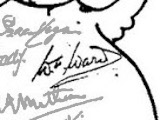

|
 | William A Ward(1889-?) |  |
||
|
William Albert Ward was born in Clerkenwell, London on 5 February 1889, second of the four children of Manchester-born hairdresser William Ward and his wife Elizabeth. His father died while William was still a child, and the family moved in with Elizabeth's newly-married sister Annie and her husband Frederick Mercer. As Frederick's family grew the two households moved to share a building. Elizabeth returned to her previous occupation, gold embroiderer for a military tailor, and on finishing school her elder daughter joined her in the work. William found employment as an artist and designer, but in June 1908, at the age of nineteen, he enlisted in the Army. His enlistment form describes him as 5' 3⅝" tall, 120 lbs, with a fresh complexion, blue eyes and light brown hair. In November 1909 he wrenched his right knee while out running, and this led to synovitis. After an operation to remove Lipoma Arborescens from the knee in April 1913 and further hospitalization in December, William was discharged as unfit for active service in March 1914. Presumably he returned to working as a commercial artist, perhaps on comics given his later career. However, at some point he must have become involved with animation. It is not known for whom he worked — a reminder that not all creators of animated films worked alone, and indeed some credited artists only supplied artwork and ideas, leaving unnamed animators to bring them to life — but it would seem to have been one that was experimenting with the 'American system' of continuous animation on paper, as opposed to the cut-out animation that had been adopted in Britain. This could have been Kine Komedy Kartoons, where American animator "Vet" Anderson was employed in 1920 to demonstrate the "American method" to its staff, but I have found no evidence to link Ward with that particular studio. In 1924, with the importation to the UK of the highly popular Felix cartoons prompting British animators to pitch animal characters to prospective distributors, it would seem that Ward hit on the idea of animating the equally popular UK magazine cartoon character G E Studdy's Bonzo the Pup. I base this assumption on the fact that Ward gets credited as producer of the series, and that without having the means of animation production at hand neither Studdy nor New Era would have had sufficient reason to initiate a such a series themselves, or if they did, would have approached an established animation studio rather than an untried individual. It is possible, however, that the studio where Ward worked was approached and that when they turned it down he offered to take it on. Having got Studdy's agreement Ward presumably approached New Era Films for a distribution deal. It would appear the head of New Era, E Gordon Craig, was enthusiastic about the idea as the company agreed to finance the the series and house the production unit. The series was to be animated using the 'American method' (the animation inked on successive sheets of punched paper, with static elements and backgrounds inked on celluloid overlays). To assist him Ward advertised for artists and in the summer of 1924 assembled a team of eleven young men and women with skill in line drawing but, in most cases, no experience of animation. As one of the novices, cartoonist and animator-to-be Brian White recalls in his memoirs, "After one week’s trial we started work in earnest." The first film, initially just titled Bonzo, shows Studdy's close involvement. Besides working with Ward to devise the story it is likely that he drew set-up drawings for each of the scenes, as well as Bonzo's various action and reaction poses. Bonzo's canine behaviour is perhaps most evident in this film, although it remained an important element in the early entries to the series (in later films he became more of a generic animated character, with less emphasis on his canine existence, much as Felix became less limited to purely feline pursuits). Bonzo was completed by the end of September, screened for the trade in October and shown to the public on November 10 as part of the supporting programme at the Royal Premiere of New Era's documentary feature Zeebrugge. It was well received, but the time spent on it is likely to have exceeded the intended production time. The production schedule probably required a release every fortnight, so the pressure was on to get enough episodes ready to enable this. Ward was presumably responsible for devising the stories in collaboration with Studdy, breaking them down into scenes for Studdy to illustrate as layouts (although as the team grew familiar with his style Studdy was probably called on to do less of this on later films) and handing them out to his team to work on, while retaining important or demanding scenes to animate himself. The first episode of Bonzo went on general release on 26 January and the second four weeks later on 23 February. It may be that the first episode proved so successful that it was worth delaying the release of the second episode to gain maximum bookings for the first. From then on the fortnightly release schedule was maintained. At first the animation team worked in New Era's offices in Soho, but they subsequently moved to premises in Holland Park. The Electoral Registers for 1926 and 1927 show William Ward and his wife Alice living at 65 Holland Park, so that might have been the location of the studio. It seems that production of the Bonzo series was completed by the summer of 1925. As well as hoping for a futher series for Studdy's dog, Ward had ideas for a new series of his own. But despite the success of the Bonzo films New Era was not interested in further animation production. It is likely that the returns simply did not justify the expense. Doubtless Ward tried other distributors, but according to Brian White, who had remained at the studio in the hope of further work, "Nothing came of it despite the Sunday Express devoting the best part of their film page to Ward’s proposed new series of cartoon films." It is may be that initially Ward turned to animating for advertising films, the only commercially viable work for animation studios, but at some point he gave up on animation in favour of other creative art jobs, again possibly in comics. In 1937 he was hired by Odhams Press to draw a series of continuing Donald Duck stories for Mickey Mouse Weekly. He completed 12 fantastical adventures from 1937 to 1940, initially using supporting characters drawn from the Disney shorts but also adding characters of his own invention. The plots maintained excitement with unexpected twists and turns, and Ward's stories were among the first Donald Duck adventures. In 1939 he also drew Jumping Jiminy ("the kangaroo who's always on the hop") for the Dandy and from 1940 he worked for Gerald G Swan, a publisher who, on the outbreak of WWII, started publishing American-style comics to replace the now hard to get American imports. Ward produced stories ranging from 'Funny Animals' (Sheriff Fox) to 'Occult Thrills' (Krakos the Egyptian}. He seems to be in his element creating hard-boiled thrillers with dialogue in an exuberant American vernacular, drawn in a crude but effective style, modelled on the original US imports, that allowed him to maintain a rapid turnover. He continued working for Swan throughout the 1940s and into the 50s. I have not been able to determine when William A Ward died.
|
Filmography | ||||
| Bonzo (series of 26 films) | (New Era Films, 1924-5) Producer, Director, Animator | |||
Links to Other Sites | ||||
Comics UK Forum - replies to a post from American animation historian and writer David Gerstein requesting information on Ward. Includes scans from an article about his work for Gerald G Swan. | ||||
BFI Player Bonzo: Video of the first Bonzo film. | ||||
BFI Player Bonzo No. 5: Video of the fifth Bonzo film. | ||||
YouTube Bonzo in Tanked: US release of Bonzo in the Army, transferred with added soundtrack by Tom Stathes. | ||||
YouTube Bonzo the Pup in Dog-Gone: US super-8 cutdown from Zoo-Ology or Bonzo at the Zoo. |
Peter Hale
Last updated 2019
|